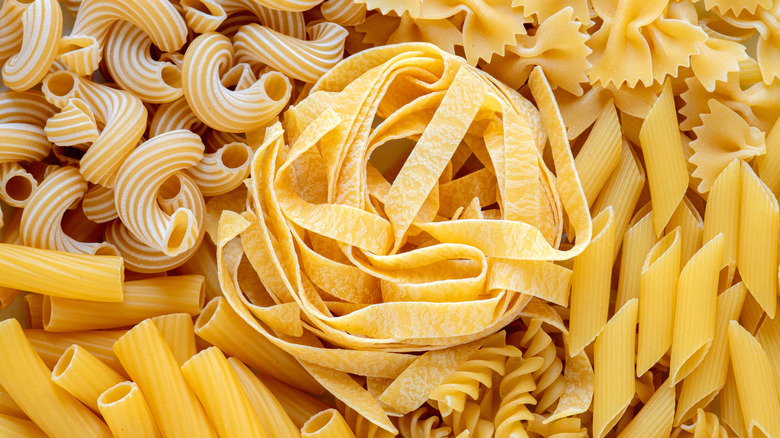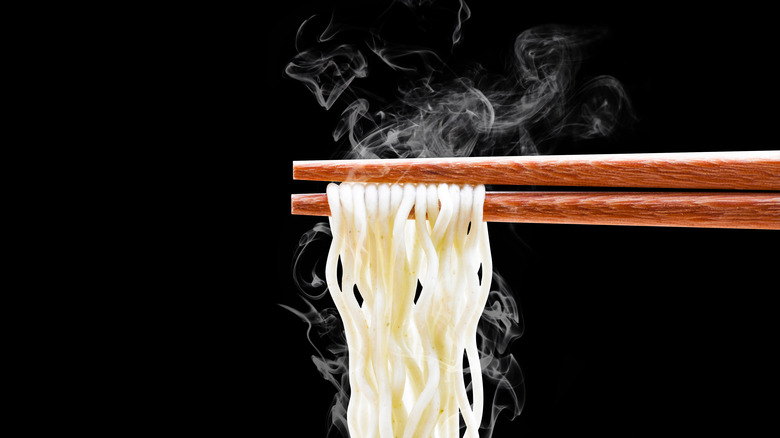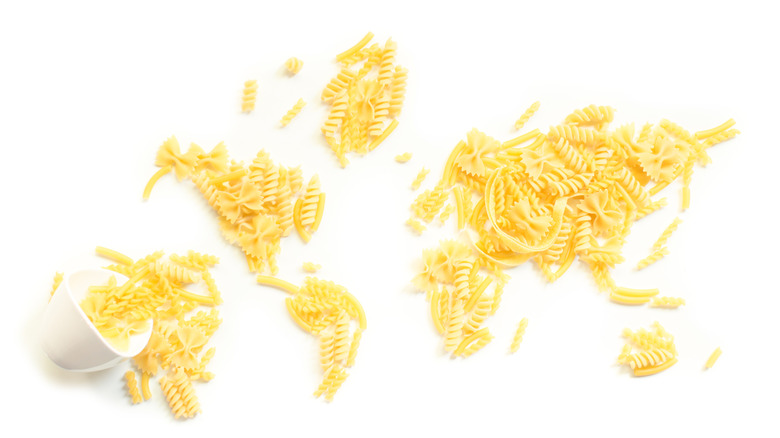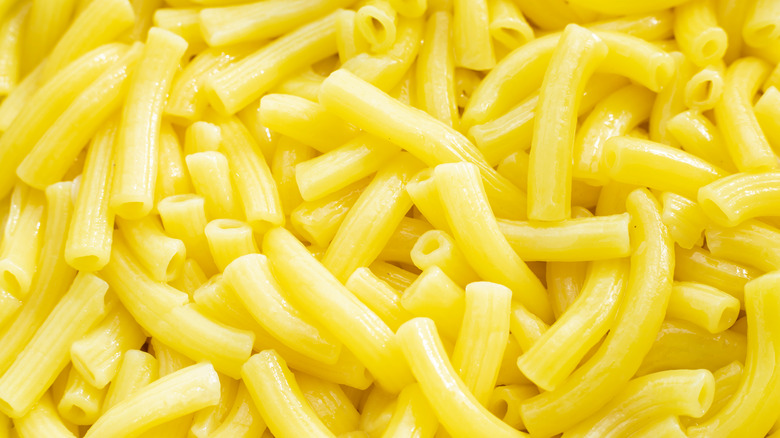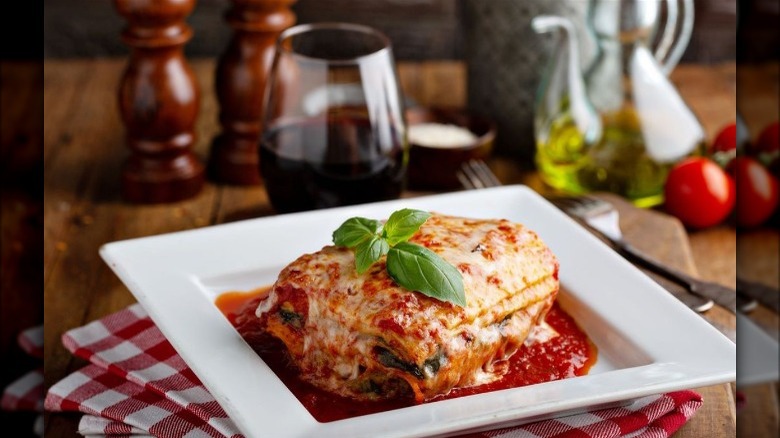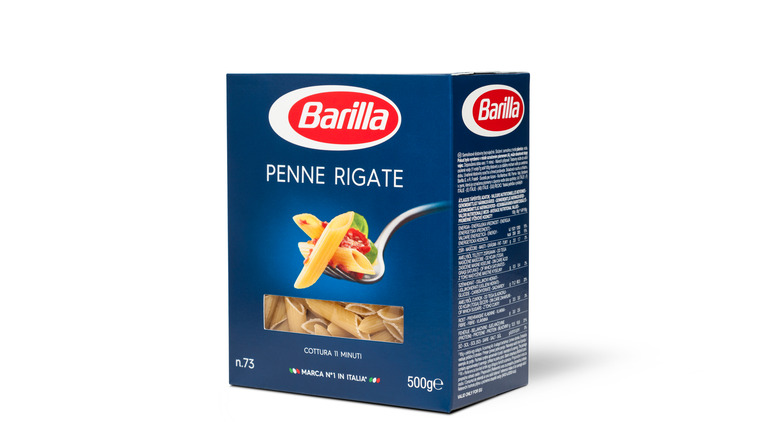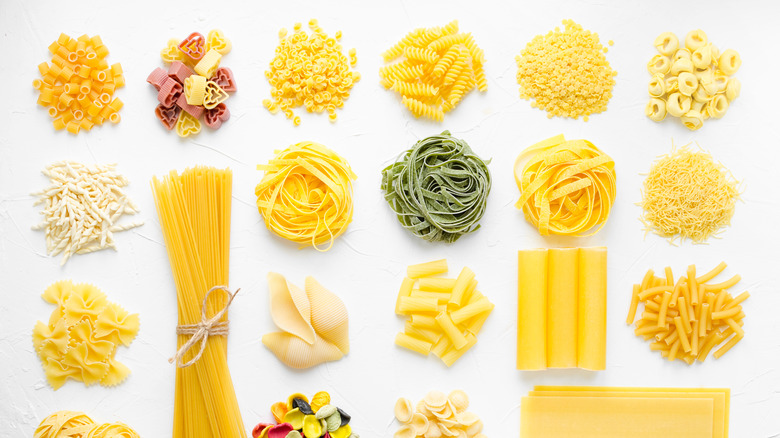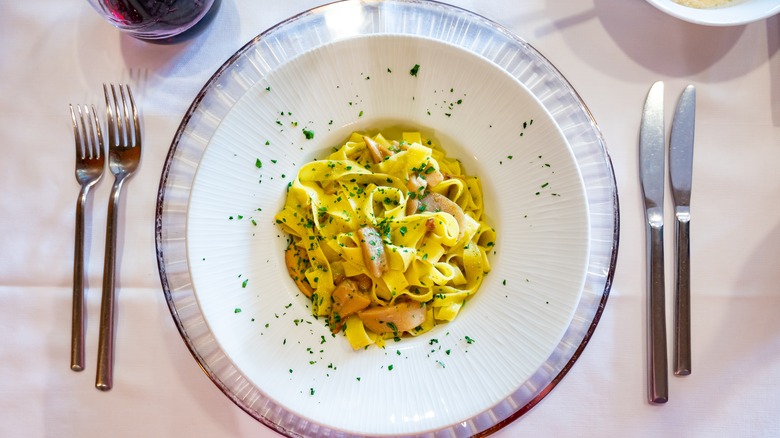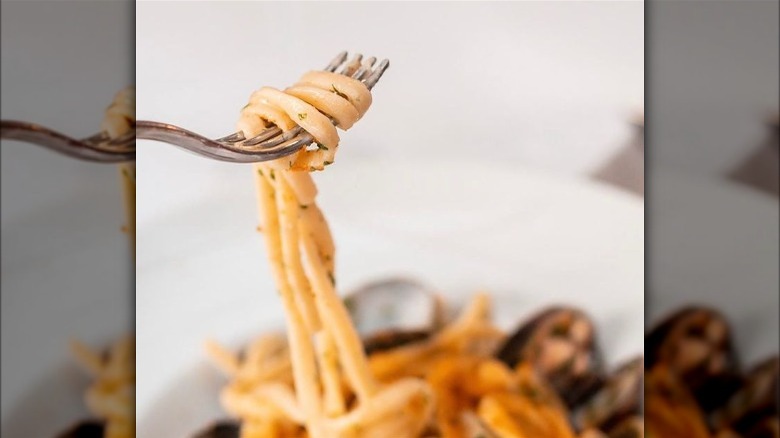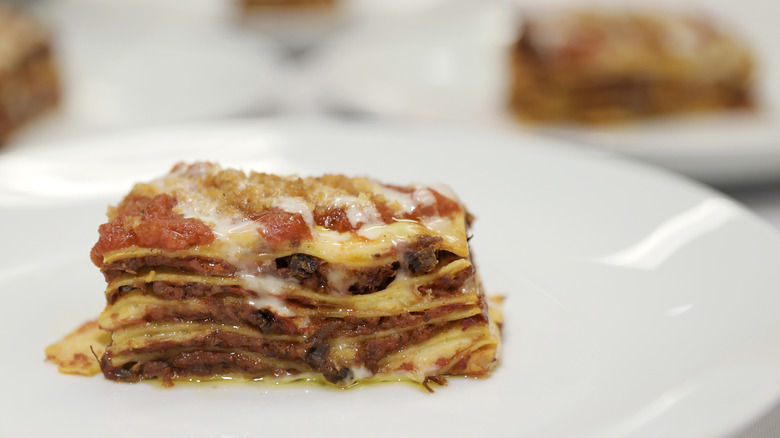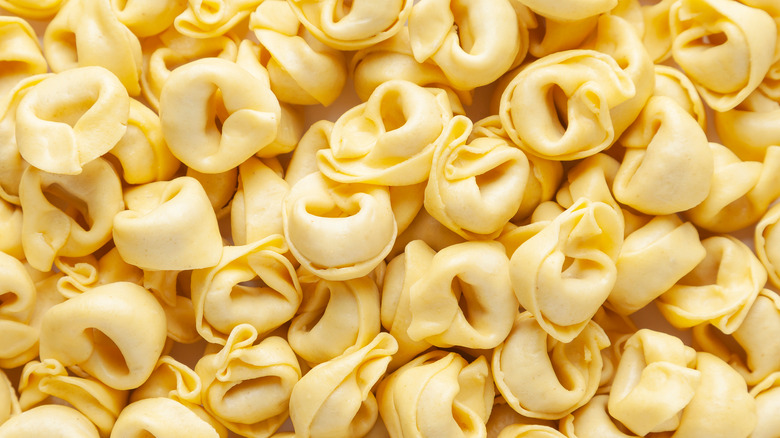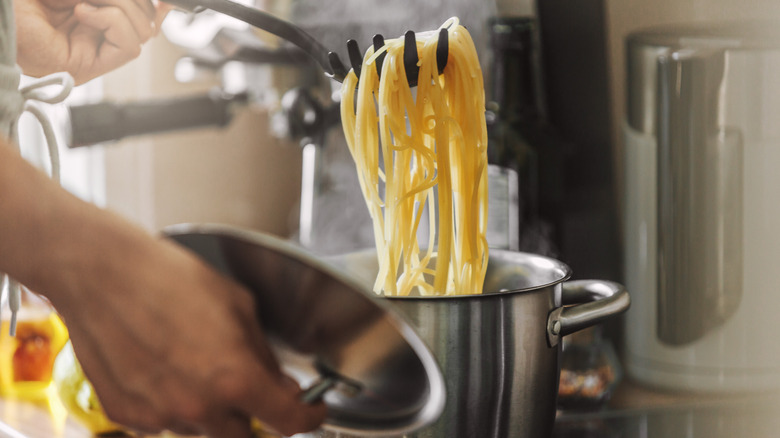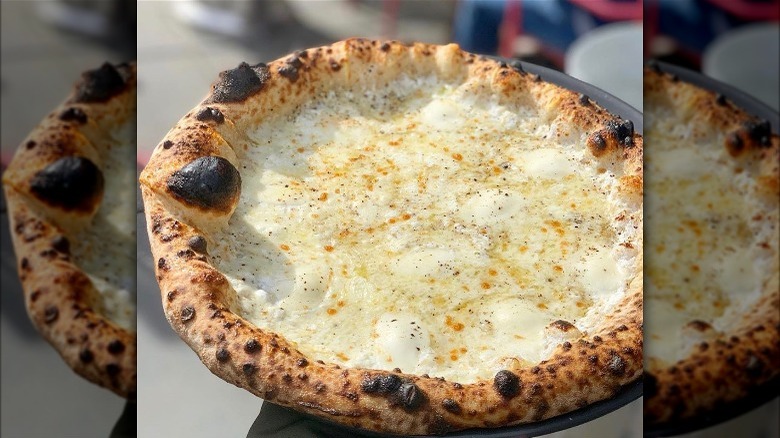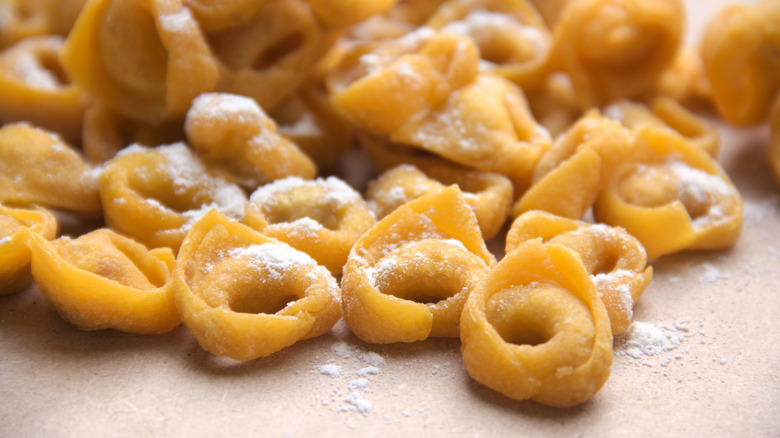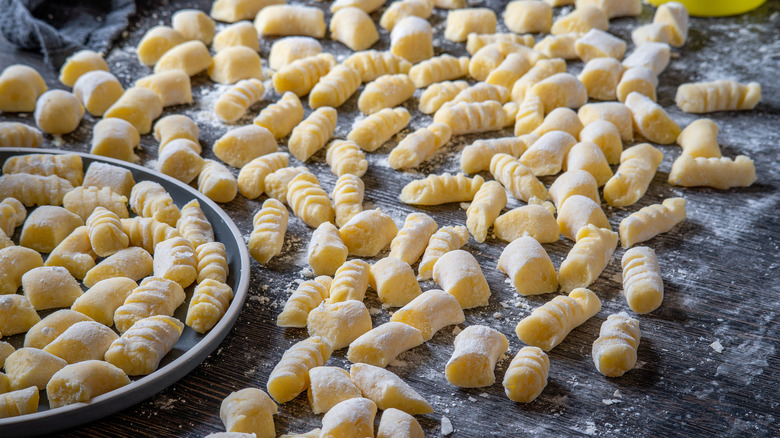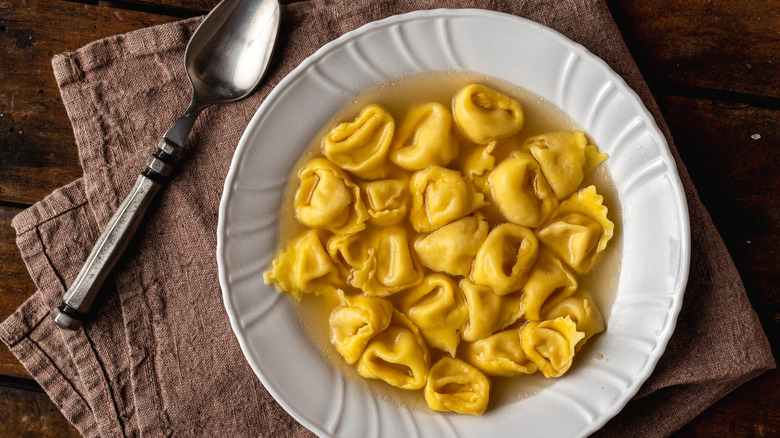The Untold Truth Of Pasta
There is no simple or fast way to delve into the history and cultural traditions related to pasta; it's easy to make, fast to prepare, and immensely comforting to eat. John Dickie, professor of Italian Studies at University College London, designates pasta as "a cultural phenomenon" (via BBC News). He adds, "People like the Italian way of life and their simple, staple foods." According to a 2011 Oxfam survey, pasta is one of the top-three foods worldwide (via Time Magazine).
Pasta became a global phenomenon beyond the Mediterranean in the 20th century when a wave of Italian immigrants moved to the U.S. and brought their cultural traditions with them. Italian American communities and their culinary ways have done much to bolster global perceptions of Italian food.
Yet, these details are the tip of the iceberg in terms of the history and traditions associated with pasta. If you enjoy the unique warmth of a pasta dish, you should know that there's so much more to pasta than al fresco dining, warm Italian breezes, and silky pasta noodles soaked in slow-cooked bolognese meat sauce.
Pasta didn't originate in Italy
For those who love pasta and admire the Italian delicacy with adoring eyes, the true origins of pasta are often a hotly debated topic: According to The Atlantic, pasta is actually a Chinese invention although it is likely Italians who first served pasta with its own sauce. For Italians, preparing pasta is a practice with a history of deep ties to family tradition and centuries of craft mastery (via Forbes).
Let's start with the true definition of pasta: According to PBS, pasta specifically refers to Italian noodles. Other types of noodles around the world have different names and culinary traditions of their own. The debate surrounding pasta's origins peaked after the publication of a 2005 article that revealed the presence of late Neolithic noodle remains at an archeological site in China (via CeCmc). According to DeLallo, pasta's earliest origins can be traced back to Shang Dynasty in China (1700-1100 B.C.).
Some assert that pasta is an Italian invention and cite 4th-century imagery from an Etruscan tomb depicting a pasta board and pin as evidence. American historian Charles Perry, however, refutes this, on the basis that the pin may have been used for several different purposes aside from pasta.
According to Perry, the first reference to noodles can be found in a 5th-century Talmud text. Despite the residual disagreement, the rollercoaster pasta debate can be concluded with one final thought: Regardless of where you land on the origins of pasta, you certainly enjoy some saucy pasta and descend into pure bliss.
Marco Polo did not introduce pasta to Italy
Pasta legend is alive and well, but as new archeological evidence surfaces, mythology is being left behind and replaced with true history, thus attracting pure fascination and curiosity (via The Atlantic). Until recently, a standardized myth suggested that Marco Polo was the first to introduce pasta to Italy. And while Marco Polo's name lends itself well to prompt credence, this legend is actually false.
According to Share The Pasta, Marco Polo returned to Italy in the late 13th century; however, archeological evidence of pasta in Italy dates to the 4th or 5th century (via PBS). So, while Marco Polo may have been enamored with Chinese noodles, he certainly did not introduce Italy to pasta.
Food historian and author of "Dining With the Ancient Romans," Giorgio Franchetti, is quick to dismiss the Marco Polo pasta recount, exclaiming, "It's pure nonsense. The noodles that Marco Polo possibly brought back with him...were essentially made with rice and based on a different, oriental culinary tradition that has nothing to do with ours" (via Today Online).
According to Farina Neighborhood Italian, there is evidence of a soldier from Genoa with a basket of "macaronis" in the 1270s, and 100 years before that, al-Idrisi, a Muslim geographer, made note of Sicilian pasta production.
Jefferson brought the macaroni machine to the U.S.
Today, former president Thomas Jefferson is still remembered for bringing over the macaroni machine after serving as ambassador to France (via Share The Pasta). Returning home from Paris after his diplomatic residency, Jefferson brought the first-ever macaroni machine to the U.S. in 1789. Documents from the Library of Congress contain hand-written notes by Thomas Jefferson himself about the macaroni extrusion press, complete with drawings and detailed descriptions (via Museo Giovanni Fabbri).
Jefferson may be remembered for bringing the macaroni machine to the U.S. but contrary to popular belief, pasta headed west long before Thomas Jefferson sailed home. According to PBS, early Spanish settlers were the first to introduce pasta to America. By the 19th century, Italian immigrants were pulling up to American coastlines and giving the U.S. an added push towards becoming a country that would soon be bursting with pasta adoration.
Italian "maccheroni" refers to any durum wheat semolina pasta (via La Cucina Italiana). The shape of American macaroni (of the macaroni that is served ladled with cheesy gravy in the quintessentially American classic mac and cheese dish) is closer to that of the "pipette" Italian pasta.
The first U.S. pasta factory was opened by a Frenchman
Since the introduction of pasta to the U.S., demand has continued to increase. Eventually, pasta became so popular that commercial pasta production was the only way to satisfy demand, so, French immigrant Antoine Zerega opened the United States' first pasta factory in 1848 (via I Love Pasta).
The first Zerega's pasta factory relied on a single horse to power pasta machinery. Dry pasta was laid out to dry in pasta strands in the sunlight on Brooklyn, New York's waterfront. And, while pasta conjecture certainly doesn't need any more controversy, according to The Atlantic, there is an alternative tale suggesting that an unknown Frenchman could have opened the first American pasta factory in 1798 in Philadelphia. Although, since the details of this account remain fuzzy, it is safe to assume that Zerega was most likely the first mainstream pasta factory in the U.S.
By the 1930s, Mr. Zerega passed on the family business to his two sons and two nephews, and three decades later, Zerega pasta was leading pasta production nationwide (via Zarega). At the start of 2020, the Philadelphia Macaroni Company acquired Zerega. Today, the operation continues to supply the finest pasta to food service businesses across the country.
Barilla is the most popular pasta brand in Italy
If you walk down the pasta aisle of any mainstream supermarket in the U.S., you're likely to see blue boxes of Barilla pasta with bright red font. Whether it's rotini, penne, or linguine, many of us envision the Barilla brand blue box at the mention of pasta.
If you buy Barilla pasta, then you may associate a cozy and comforting night indoors with pouring the contents of the box into a salted pot of boiling water as the window fogs up from the rising steam and the dried pasta morsels head towards al dente perfection.
It's easy to get carried away with pasta infatuation in the U.S., but Barilla is a thriving brand on the other side of the pond too. Italians love convenient boxed pasta just as much as spaghetti-crazed Americans. In fact, according to Forbes, Barilla is the leading pasta brand in Italy. The company started as a small family-run business in Parma, Italy, and went on to become Italy's most successful pasta brand.
According to Statista, Barilla was the most widespread dried pasta brand in 2017. Barilla took up 41% of the market share in 2002. Nearly two decades later, those numbers haven't budged. According to Barilla's company website, Barilla is still Italy's top pasta brand of choice 140 years after its establishment.
Each pasta shape exists for a reason
Playful, tennis racket-shaped rachette pasta, tiny rice-like orzo, and famously saucy rigatoni dishes don't even begin to cover the world of pasta shapes. According to The Washington Post, there are over 300 types of pasta, while Eataly suggests that there are more than 400 pasta varieties. Either way, each kind of pasta serves a very specific purpose.
According to cookbook author Katie Parla, there are two different pasta shape camps: The American "do whatever you want" approach, and the Italian way, which approaches pasta shapes with deep consideration for pairing the right shape with a suitable sauce. But pasta shapes aren't just designed to coat, trap, and cling; the shape of pasta is also based on its regional location of origin.
Regional produce is essential for fashioning delicious pasta plates and local grains often influence pasta dough production. For example, northern Italian pasta is usually made with soft wheat flour grown nearby, and eggs are generally added to supplement the flour's low protein content.
Gnocchi is native to northern Italy and the colder climate in this region is great for growing potatoes and unctuous butter dressings (via DeLallo). Central Italian pasta can be made with or without eggs. Meanwhile, southern Italy produces pasta made with high-protein local durum (semolina) flour. The chunky sauces of the southern region pair well with cavatelli and other nook-and-cranny pasta shapes that help trap and retain the sauce (via Paesana).
In Italy, pasta is served before the main course
Picture a villa in Umbria, complete with old stone masonry, a table under the patio's lush canopy, and olive tree orchards within spitting distance. The table has been set, bubbly prosecco and small nibbles are ready to go, and guests are starting to settle in for a proper Italian course menu. The antipasti platter is laid out, likely featuring a selection of local cheese, salumi, vegetables, crostini, or olives.
After the antipasti spread is served, the primi is set to take center stage. The primi is the official first course; it is designed to tease appetites before the secondi or the main dish (via Cucina Toscana). But you won't have to hold your breath until the third round to enjoy a plate of pasta. In Italy, starchy pasta, polenta, and risotto are all served prior to the mains in dry, fresh, or stuffed forms (via Sapore Dispere).
In the U.S., a typical three-course meal commences with a few nibbles for appetizer hour, and shortly after, it's time for the main course, which may consist of a meaty bolognese lasagna, baked ziti, or spaghetti with red sauce, if we're sticking to American impulses.
Pasta is often part of the main course in the U.S., but in Italy, if pasta is the carb of choice, it is presented in judicious servings (nothing like the plates we see here). Lasagna is also considered a primi in Italy, although it was part of the "one-dish madness" of 1950s America (via NYT Magazine).
Spoons are a no-go when eating pasta
As Italian writer and food legend, Anna Del Conte writes in her book "Gastronomy of Italy," "The other source that sustains the variety, the appeal, and above all the quality of Italian cooking must surely be the intense concern the Italians have, from early childhood, with what they eat and how it should be cooked." Pasta is no exception.
Every step of the cooking process, down to the last forkful, is a science; a ritualistic proceeding that allows for nuanced enjoyment while also adhering to ancient guidance. When cooking pasta, one must never add oil to the pasta water or overcook pasta into mush.
Pasta can be messy and uncooperative, but according to a 1982 article from The New York Times, spoons should stay clear of all pasta plates. Restaurant owner Egi Maccioni shared, "My grandparents spent hours teaching me how to eat pasta without a spoon ... At home, if I couldn't master the technique, they'd punish me by taking all the food away."
Tables ready for pasta may be set with spoons and forks, intended to toss the pasta together at the start of the course. After that, however, spoons should remain plate-side. To fully commit to the Italian way without unnecessary struggle, etiquette guru Myka Meier suggests resting the tines of the fork against the plate or bowl, picking up only a few strands, and twirling to grip and wrap spaghetti strands around the fork (via Hello Magazine).
Baked pasta was was once exclusive to the upper classes
In Italy, during the middle ages, economic class distinctions and food were interconnected (via Gastronomy of Italy). During the 14th-century Renaissance period, Italian cuisines flourished and traveled well beyond Italian borders to the rest of Europe.
Renaissance philosopher Platina was both an active humanist and gastronomist who brought attention to unequal access to food between the wealthy and the poor by shaming wealthy peacock feasts and fancy meat "work" in his writings (via The Oxford Companion to Italian Food).
Food managed to wage a divide between the rich and poor well into 20th-century Italy. Believe it or not, while America was becoming smitten with convenient lasagna and macaroni in the 1950s; however, back in Italy, baked pasta dishes (pasta al forno) remained relatively exclusive to the upper class (via The NYT Magazine).
Pasta historian Anna Del Conte revealed, "Twenty years ago in Rome, you would never be served pasta at a formal dinner unless it was baked ... Baked pasta was not a peasant dish. Only rich people had ovens." Luckily, these days, ovens tend to be a lot more accessible.
Bologna is the stuffed pasta capital of Italy
Pasta-making is an artform in Italy: Female pasta pros have earned the title of "sfoglina," a term that refers to the women who specialize in making handmade pasta using a rolling pin (via The Washington Post). If you go straight to sun-kissed Italian islands or Tuscan villas when you visit Italy instead of a Bologna pitstop, you might be missing out on some of the best fresh and stuffed pasta in all of Italy (via Conde Nast Traveler).
According to National Geographic, Bologna is Italy's epicenter for all things tortelloni and meat ragu; additionally, it is an overall excellent place to start a culinary escapade. Stuffed pasta varieties, such as agnolotti, tortellini, and ravioli, should be made fresh to be enjoyed as precious pasta morsels. Northern Italy, including Bologna, runs on fresh pasta: Since the wheat stemming from the region tends to be lower in protein, the pasta made in northern Italy often requires the addition of eggs (via Eataly).
Tortellini consists of resh pasta squares and a smooth meat filling and it has been Bologna's most prized pasta since the 1500s. The filling is hand-stuffed with a mixture made of locally aged Parmigiano-Reggiano, regional minced mortadella, prosciutto, pork loin, eggs, and nutmeg. Amazingly, tortellini "sfoglinas" can produce 4,500 small tortellini every 24 minutes, which is more than enough to produce a satisfying bowl of pasta.
Al dente pasta is actually overcooked
According to National Geographic, overcooked pasta has its moment in 16th-century Italy; however, most esteemed home cooks respect modern al-dente sensibilities and remove pasta a few minutes early to ensure an al dente, or "to the tooth" chew. But what if cooking pasta al dente actually overcooks it? If that was the case, then all the al dente goals we've internalized since becoming self-proclaimed home cook prodigies would go out the window, right?
Well, not exactly. The end goal remains the same: The Pasta hits the table piping hot, full of saucy flavor, possessing the perfect al dente texture that doesn't turn to paste in the mouth. According to Bon Appétit, specific pasta dishes require an earlier exit from boiling water. If you're cooking a pasta dish in a pan of flavorful sauce (which is highly recommended), aim for "molto al dente" (undercooked pasta). Remove pasta from the pot about three minutes before al dente and then finish cooking the desired sauce.
Cacio e pepe isn't just for pasta
Cacio e pepe is currently one of the trendiest pasta dishes across the globe. Some critics knock the mainstream attention it receives, claiming the dish is nothing more than pasta, pecorino cheese, and cracked black pepper. Others, like Felicity Cloake, writer at The Guardian, stick up for the Roman pasta dish, calling it a plate that has "entered the collective psyche of foodies" everywhere.
If we've learned anything about pasta and cooking in general, it's that just because a dish is simple doesn't mean skilled finesse is disposable. And if you've ordered cacio e pepe at a restaurant or attempted to make it at home, you know how difficult it can be to get just right. Avoiding cheesy clumpiness is actually an impressive skill.
The cacio e pepe trend had diverged from pasta plates and ventured deep into the realm of eating possibilities. Stellina Pizzeria in Washington, D.C. has a considerable fanbase devoted to its cacio e pepe pizza, which has a tender charred crust with a ricotta cheese base, mozzarella cheese, Percorino Romano cheese, and lots of black pepper (via The Washington Post). Other cacio e pepe-inspired creations, such as crackers and eggs are all pretty incredible too, although the verdict is still out on cacio e pepe ice cream.
Tortellini pasta is inspired by Venus' navel
Tortellini's mythological lore is more significant than any other Italian food (as per NPR). According to legend, the small meat-stuffed pasta was inspired by Venus (the goddess of love), specifically, her belly button. Supposedly, a tavern innkeeper in Castelfranco Emilia caught a glimpse of Venus' navel through the keyhole of her door. After the sighting, he hurried to the tavern kitchen with Venus as his muse and created the tortellini shape we enjoy today.
According to Gianni degli Angeli, president of the San Nicola Association, and three-star Michelin chef Massimo Bottura, tortellini captures the heart of Emilia-Romagna's cultural and gastronomic identity. Today, the town of Castelfranco Emilia (home to the first tortellini) hosts an annual Tortellini Festival every September. The festivities include historical reenactments and tortellini tastings; additionally, one lucky local is awarded the title of "innkeeper," and is designated custodian of tortellini tradition for that year (via Visit Modena).
Gnocchi preceded pasta
Although Trader Joe's cauliflower gnocchi is a trend in the U.S., it might garner perplexed, if not offended, glares from proud Italian sfoglinas. While Trader Joe's gnocchi is popular and quite delicious, true Italian gnocchi, although extremely regional and varied, is unlikely to contain steamed cauliflower.
According to Saveur, gnocchi's true origins are a topic of ferocious Italian debate. There are several different kinds of gnocchi: Some of these may incorporate ingredients such as flour, potato, chestnut flour, spinach, and ricotta cheese, among others.
Potato gnocchi may have originated in the 16th or 17th century, after Spanish explorers brought potatoes to Italy after their travels in South America. Some believe the earliest gnocchi was created in the 1st century and was made with semolina flour and water or milk.
Gnocchi made with bread, milk, and ground almonds, known as "Zanzarelli," was invented in 15th-century Lombardy. Meanwhile, Bartolomeo Scappi featured a gnocchi recipe in his 1570 cookbook made with flour-based dough and breadcrumbs. However, it wasn't until the 19th century that potato gnocchi plates started resembling modern iterations, thanks to Italian food legend Pellegrino Artusi.
Some Italian recipes entail cooking pasta in stock
Many people consider chicken, beef, and vegetable stock as essential pantry staples: Do you need to thicken gravy or soup? Add stock. Want to recover overcooked meat? Add stock. Do you have a pan that needs deglazing? Add stock. Stock is an edible equalizer infused with herbs and other ingredients. It is used all over the world to add flavor to dishes. Unsurprisingly, cooking pasta in stock leads to incredible results, and Italians figured this out a long time ago.
According to "Gastronomy of Italy," meat stock and vegetable stock are Italy's most utilized types of "brodo." Italian dishes such as "tortellini in brodo" utilize stock in their recipes. The culture of stuffing pasta and poaching the meaty pasta pockets in a chicken, beef, capon, or veal stock is a treasured tradition in the Emilia-Romagna region, especially during the holiday season (via La Cucina Italy).
Tortellini culture is so integrated that passionate shopkeepers encourage customers to taste their prized tortellini upon entry into the store. Another Christmas-time favorite in Emilia-Romagna is "cappelletti in brodo," which is a dish that consists of stuffed pasta in broth (via Forbes).
Whether a big holiday calls for celebration or a family dinner beckons for laughter and smiles, stuffed pasta simmering in pots of stock brings people together instantly. It's no wonder that pasta is near and dear to so many hearts.
